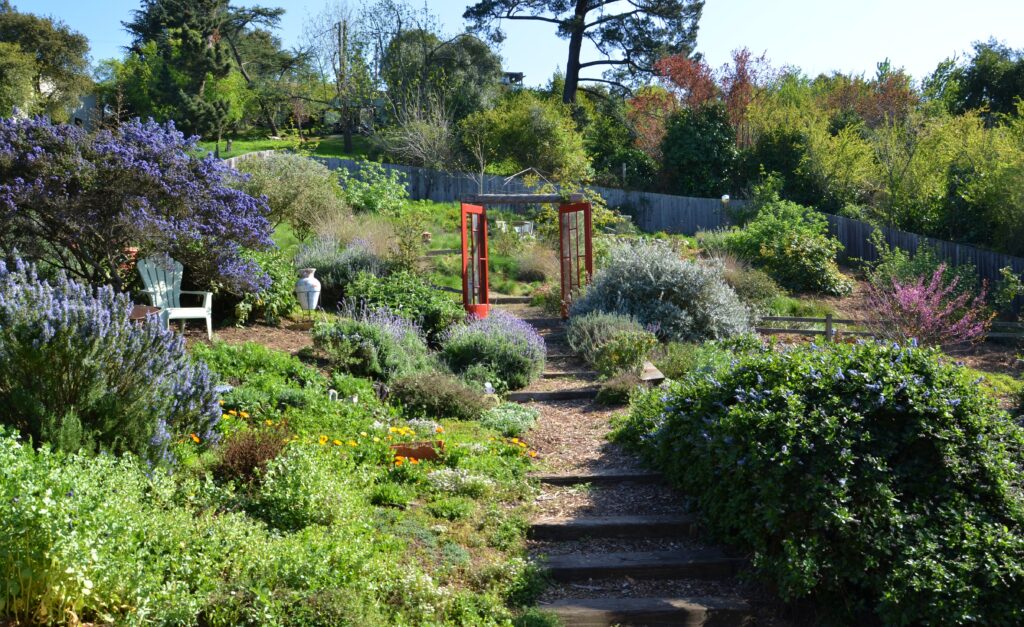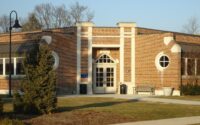For The Health of Students and The Environment, Gettysburg College Needs to Rewild Campus Greenspaces
By Sarah Gilsoul, November 11, 2021

Imagine walking to class underneath a canopy of oaks and silky willows. Native flowers and grasses like the early goldenrod and the woodland sunflower line the paths. The hundreds of butterflies and moths that rely on these species flutter around as you make your way through campus, and you can hear dozens of birds chirping in the trees above. The landscape creates an atmosphere of peace and positively impacts your mental health. However, this is not the experience that we encounter as we make our way through the grounds of Gettysburg College. Much of the land is a carefully curated array of ornamental, non-native plant species and turfgrasses. The plants do not provide the same kind of ecological support for local butterflies and moths, and without the insects, there are very few birds. The spaces that fill up the campus landscape may look green, but they are not teeming with life in the way nature should.
Colleges and Universities across the country are beginning to understand this fundamental difference and are rewilding their campuses by restoring natural habitats on campus green spaces. Gettysburg College needs to join the movement, not only for the sake of the local ecosystem, but creating more natural spaces may promote a happier and less anxious campus community.
Mental Health on College Campuses
Mental health disorders have become steadily more prevalent in college-aged students over recent years. According to the Clay Center for Young Healthy Minds, almost half of college students had a psychiatric disorder in the past year, 73% of students experience a mental health crisis during college, and nearly 1/3 of students have felt so depressed that they have trouble functioning (Schlozman et al., 2017). Even more disturbingly, only 25% of students with mental health issues seek help.
Gettysburg College is no exception. A junior English major at the college, Caroline Kurt states that she often feels anxious at Gettysburg. French major Maxine Hendrix also reported feelings of stress and anxiety while on campus. Across the campus community, within every department, students are experiencing mental health problems. While there are counseling services available, students often do not reach out due to concern of not having enough time or even the fear of acknowledging that they have a mental health issue to begin with. If students are not going to take advantage of the resources available to them actively, then the campus needs to help the student body in ways that only require passive involvement. One possible way to do this is by rewilding our campus’s green spaces.
Wild Spaces and Mental Health
Conservation Biologists Cox et al. (2017) conducted a peer-reviewed study on the impact of different vegetation types and the amount of coverage on mental health. They found that increasing the percentage of vegetation cover greater than 0.7 meters (or a little over 2 feet) in height in areas surrounding residential spaces correlates to lower rates of anxiety, depression, and stress, all issues students at Gettysburg College regularly face. Specifically, if vegetation that meets the height requirement covers at least 20-30% of the landscape, mental health issues are reported to be significantly lower (Cox et al., 2017). Another study done by horticulturists Chiang et al. (2017) found that participants experienced significant stress reduction in forest interiors compared to those on edges or exteriors of forests.

While there are trees scattered across campus, there is not a forest by any means, which implies that students and faculty are not receiving the stress reduction that being inside wooded areas can bring. Standard turfgrass, which covers much of the campus now, is kept at a height of only a couple of inches, which is not tall enough to impact students’ mental health substantially. Students at Gettysburg College can feel this difference. Senior Anthropology major and hiking enthusiast Shelby Deron, says “When I’m in a wilder environment, it kind of feels homier. It’s almost like a safety blanket to be surrounded by more of a forest atmosphere.” Natural landscaping can create this type of environment because it involves a variety of native plants and trees, all varying in height and with the ability to grow in a less tamed or manicured manner. If we implement rewilding efforts on a large scale, it has the potential to create that “wilder” feeling and improve students’ mental health.
According to an academic study done by entomologists Bughardt et al. (2009), natural landscaping with native plant species also attracts butterfly and moth species more than landscapes with mostly ornamental and exotic plants (Burghardt et al., 2009). In these environments, birds are also more abundant, most likely due to their reliance on caterpillars for feeding their young (Burghardt et al., 2009). While there is a clear ecological benefit to having more native plants on campus, a greater abundance of birds in the environment also correlates to lower levels of mental health issues (Cox et al., 2017).
What’s Stopping Gettysburg from Rewilding?
One of the main concerns raised when campuses and organizations discuss rewilding efforts Is the initial cost and maintenance. Native species are not as expensive to plant when compared to the price of ornamental species. However, the issue arises because Gettysburg College already has non-native ornamental plants and turfgrasses installed throughout campus. Creating natural spaces would require the removal of plants that are already present. Native plants would also need to be purchased and installed, which are labor-intensive and potentially expensive.
However, the initial labor needed to restore natural habitat would not have to fall entirely on the college to provide. Rewilding efforts could be student-led and would provide leadership and volunteer opportunities for students and shift the labor away from facilities.
The Hidden Costs of Lawns
The long-term upkeep of native plants can also be dramatically less costly than turfgrass and is less labor-intensive to maintain over time. According to the EPA, over 20 years, the cumulative cost of maintaining larger properties with a prairie or wetland totals $3,000 per acre compared to $20,000 per acre for non-native turf grasses (EPA, 2016).
Lawns and non-native plants have a multitude of hidden costs. In the United States alone, we use 3 trillion gallons of water for watering lawns, 200 million gallons of gas for mowing lawns, and 70 million pounds of pesticides to upkeep lawns per year (Talbot, 2016). Gettysburg College sits on 225 acres of land, meaning that making the switch to native landscaping, which does not require the same scale of upkeep, could save the school millions of dollars over time.
Moving Forward
Several colleges, such as Kansas State University and West Virginia University, have joined the National Wildlife Federation’s (NWF) Campus Wild movement and have used natural restoration projects to address flooding on campus (Jones et al., 2015). Environmental Studies Professor William Lane believes that rain gardens should be integrated into the landscaping at Gettysburg College as well and states that “rain gardens create beautiful natural habitats, but also help in managing excess water on campus.” According to NWF, these rainwater mitigation systems trap stormwater nutrients, pollutants, and excess runoff while sequestering carbon and providing habitat for local insects and animals (Jones et al., 2015). Suppose the college understands the rewilding movement as a way to improve campus functionality as well as mental health. In that case, the administration may be more willing to integrate native habitats on campus green spaces.
Radio Minute
Bibliography
Burghardt, K. T., Tallamy, D. W., & Gregory Shriver, W. (2009). Impact of Native Plants on Bird and Butterfly Biodiversity in Suburban Landscapes. Conservation Biology, 23(1), 219–224. https://doi.org/10.1111/j.1523-1739.2008.01076.x
Chiang, Y.-C., Li, D., & Jane, H.-A. (2017). Wild or tended nature? the effects of landscape location and vegetation density on physiological and psychological responses. Landscape and Urban Planning, 167, 72–83. https://doi.org/10.1016/j.landurbplan.2017.06.001
Cox, D. T. C., Shanahan, D. F., Hudson, H. L., Plummer, K. E., Siriwardena, G. M., Fuller, R. A., Anderson, K., Hancock, S., & Gaston, K. J. (2017). Doses of Neighborhood Nature: The Benefits for Mental Health of Living with Nature. Bioscience, 67(2), 147–155. https://doi.org/10.1093/biosci/biw173
Deron, S. (2021, November 10). Student Perspective on Wild Spaces. personal.
Environmental Protection Agency. (2016, February 21). Green Landscaping: Greenacres. EPA. Retrieved November 5, 2021, from https://archive.epa.gov/greenacres/web/html/factsht.html#:~:text=A%20study%20by%20Applied%20Ecological,for%20non%2Dnative%20turf%20grasses.
Hendrix, M. (2021, November 3). Student Perspective of Rewilding Efforts on Campus. personal.
Jones, K., Cochran, C., Eagan, D. J., & Goodlaw-Morris, J. (2015, September 1). Natural Areas on Campus. The Campus “Wild”. Retrieved October 15, 2021, from https://www.nwf.org/-/media/PDFs/Campus-Ecology/Resources/The-Campus-Wild/The-Campus-Wild_HR_Aug25.ashx?la=en&hash=E356D4339C15354073948D6BC4942B6D1F5C2400.
Kurtt, C. (2021, November 3). Student Perspective on Rewilding Campus. personal.
Lane, W. (2021, October 27). Faculty Perspective on Rewilding Campus. personal.
Schlozman, S., Beresin, G., & Abdu-Glass, E. (2017, February 7). The College Mental Health Crisis: A call for cultural change – part 2. The Clay Center for Young Healthy Minds. Retrieved November 5, 2021, from https://www.mghclaycenter.org/parenting-concerns/college-mental-health-crisis-call-cultural-change-part-2/.
Talbot, M. (2016, September 30). More sustainable (and beautiful) alternatives to a grass lawn. NRDC. Retrieved October 15, 2021, from https://www.nrdc.org/stories/more-sustainable-and-beautiful-alternatives-grass-lawn.


